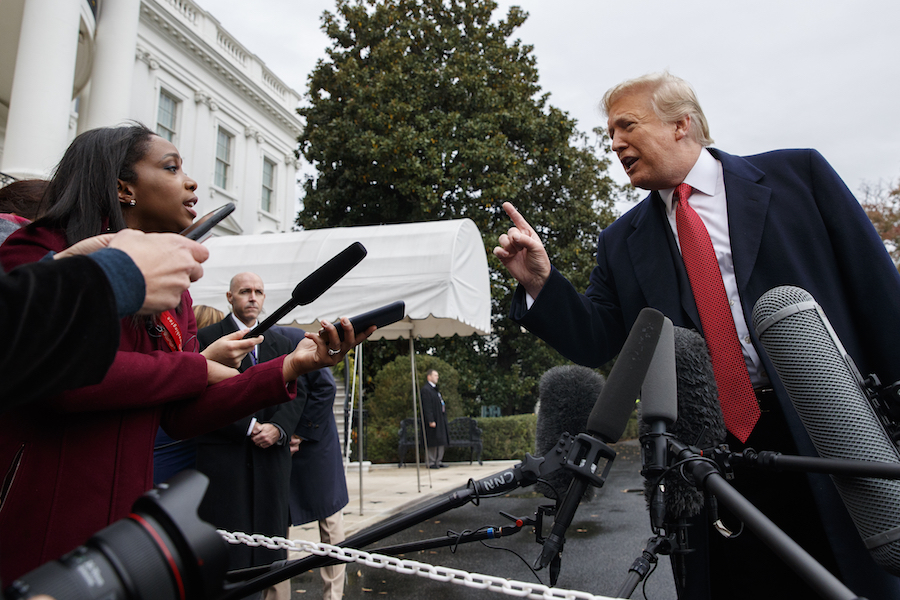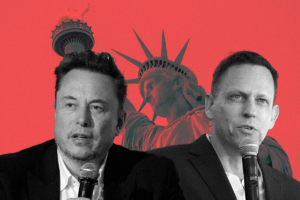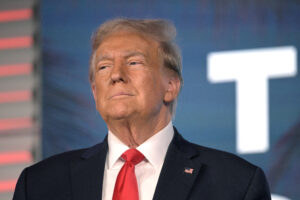Signs of Creeping Fascism Are All Around Us
This would be a good time for Americans to familiarize themselves with the essential elements of fascism. CNN journalist Abby Phillip asks President Trump a question as he speaks with reporters on the South Lawn of the White House last Friday. The president was criticized by media outlets for chiding Phillip during that exchange, telling her: "What a stupid question that is. What a stupid question." (Evan Vucci / AP)
CNN journalist Abby Phillip asks President Trump a question as he speaks with reporters on the South Lawn of the White House last Friday. The president was criticized by media outlets for chiding Phillip during that exchange, telling her: "What a stupid question that is. What a stupid question." (Evan Vucci / AP)
The talking heads I saw on cable news last week seemed baffled and disgusted by Donald Trump’s response to a black female reporter’s comment during his angry press conference following the midterm elections.
The reporter, the so-called Public Broadcasting Service’s Yamiche Alcindor, stated that the president had called himself a “nationalist” on the campaign trail last month. “Some people,” Alcindor said, “saw that as emboldening white nationalists. Now people are also saying. …”
Before she could finish, the visibly agitated president interrupted her. “I don’t know why you say that,” Trump interjected. “That is such a racist question.”
Alcindor remained cool and continued her question: “Some people say the Republican Party is now supporting white nationalists because of your rhetoric.”
“I don’t believe it,” Trump retorted. Pointing his finger at Alcindor, he said, “Let me tell you, that’s a racist question. …You know what the word is? I love our country. I do. You have nationalists, you have globalists … but to say that, what you said, is so insulting to me. It’s a very terrible thing what you said!”
While I share the talking heads’ repulsion over Trump’s battering of Alcindor, I found his outburst—one of many dark moments in the president’s faceoff with those he calls “enemies of the people” (reporters)—neither surprising nor difficult to understand.
It helped that I’d just finished reading Yale philosophy professor Jason Stanley’s new book, “How Fascism Works: The Politics of Us and Them,” a timely study of fascist politics past and present.
Stanley examines how modern authoritarian and nationalist—“fascist,” if you like (Stanley obviously does)—politicos have used and subverted purportedly democratic electoral politics to gain power. He finds 10 common themes animating fascist ideology and propaganda:
- Invocation of a mythic national past marked by racial, ethnic, religious and/or cultural purity—a supposedly glorious history to which the nation needs to return.
- Propagandistic use of outwardly virtuous ideals (including anti-corruption, democracy, liberty and free speech) to advance abhorrent ends that contradict those ideals.
- An anti-intellectual assault on education, universities, science, expertise and language, accompanied by charges of Marxism and “political correctness” against liberal and leftist enemies and the advance of simplistic nationalist and authoritarian ideals. This is fertile soil for the deadly denial of climate change that has occurred and for such absurd claims as the notion that whites are now more damaged by racism than are black, Latinx and Native American people in the U.S.
- An insidious attack on truth and on people’s ability to perceive and agree on truth. Regular and repeated obvious lying is combined with the advance of conspiracy theories and the promotion of “news as sports” and demagogic strongmen as “stars.”
- An ugly faith in natural hierarchies of worth and a rejection of equality as dangerous, unnatural, Marxist and liberal delusion.
- An aggrieved and counterfeit sense of victimhood among dominant “us” groups (racial, ethnic and/or religious) that feel threatened by having to share citizenship, resources and power with minority groups (“them”). This ironic victimology feeds an oppressive nationalism devoted to maintaining “natural” hierarchies and uniting “chosen” but supposedly oppressed racial, ethnic, religious groups (whites in the U.S., Christians in Hungary, Hindus in India, and so on.) against the supposedly false claims and unjust demands of “them”—those designated as “naturally” inferior others.
- A stern embrace of law and order that targets minority others (“them”) as criminal threats to the safety and security of the majority (“us”).
- Sexual anxiety about the threat supposedly posed by minority, criminal and alien others to “our” traditional male roles, status and family values.
- A loathing of cities seen as racially and sexually corrupt, ethnically impure, sexually perverse, parasitic criminal zones loaded with a polyglot mass of some inferior, nation-weakening “them.” By contrast, the rural countryside is lauded as the noble wellspring of virtue, strength, self-sufficiency and racial-ethnic purity. The rural heartland/fatherland/motherland/homeland is the sacred and foundational “blood and soil” preserve of “us.” It is the noble native soil of the “volk”—the true ancestral people who embody the spirit of a once-grand nation that needs to be made great again through the defeat of liberal and supposedly leftist elites who have been giving the nation’s resources and power away to naturally inferior others (“them”).
- A sense of the chosen-people majority (“us”) as hard-working, upright, virtuous and deserving, combined with the notion of demonized minorities and others (“them”) as lazy, dissolute, shifty and undeserving.
Trump’s response to Alcindor was a perfect match for the sixth of Stanley’s 10 fascist leitmotifs. How did the president turn the reporter’s mild query into a shameful expression of anti-white “racism”? Only by the possession or pretense of an oppressor-nationalist worldview that sees any suggestion of white racism as an infuriating affront to the supposed real victims of racism: white Americans. By denouncing Trump’s response to Alcindor as mere nonsense, CNN’s panelists missed the point.
It was just one of many episodes in which Trump has checked the boxes on Stanley’s list of core fascist themes. Consider Trump’s:
- Three-year-old ballcap slogan, “Make America Great Again” (likely lifted from empowered Hungarian fascists’ call to “make Hungary great again”).
- Claim to be “drain[ing] the swamp” while filling his administration with thoroughly corrupt swamp creatures.
- Designation of his authoritarian racist and hate-filled campaign rallies—events where he denounces reporters as “enemies of the people” and even applauds repressive violence against them and others—as “free speech” demonstrations.
- Climate-science denial and taste for conspiracy theories.
- Relentless totalitarian mendacity and endless nonsensical assertions, utterly devoid of evidence.
- Constant leveling of the charge of “fake news” against any reporting or commentary that questions his political agenda and purported greatness.
- Absurd advance-pardon of a racist sheriff who built Nazi-like internment and work camps for Latinx arrestees.
- Savage punitive separation of Central American children from their migrant parents at the southern U.S. border.
- Defense of white supremacists who marched through the University of Virginia campus, chanting “Blood and soil, Jews will not replace us” (Heather Heyer, a young woman protesting the fascists, was killed at that 2017 event).
- Obvious underlying belief that African-Americans, Latinx, Native Americans and women are inherently inferior to white men and unworthy of respect and equality.
- Repeated claims that leading black personalities are “low IQ,” “stupid” and the like.
- Repeated and barely coded racist appeals to “law and order.”
- Repeated false description of immigrants as rapists and other kinds of terrible criminals, not to mention “animals.”
- Mad executive order claiming to end the 14th Amendment’s guarantee of U.S. citizenship to people born on U.S. soil.
- Clear disdain and distrust of scientists, real expertise, intellectuals and independent judges and lawyers.
- Repeated reference to the predominantly white and agrarian, small-town heartland as the real soul of the nation and his related special taste for holding demagogic, fascist-style rallies in heavily white, rural, red-meat, red state regions.
- Regular false description of centrist and liberal corporate Democrats as “the left” and as “socialists.”
That’s just a short list of how Trump’s rhetoric and conduct has lined up with the noxious politics of fascism, which holds power in a shocking number of nations today. (Stanley might have added a special chapter on hypermasculinist militarism and misogyny, both major Trump themes. Perhaps, too, it is time to start thinking about eco-fascism—the special dedication fascists show for assaulting livable ecology.)
Many U.S. Democrats will read Stanley’s book with a sense of self-satisfied validation over his description of Trump and his party as fascists. That’s a shame, as well as a mistake. “How Fascism Works” should prompt Democrats to take a critical look in the mirror and at their party when it comes to how we got in this hot, neofascistic, political mess. Not content merely to describe fascist politics, Stanley seeks to explain its success, past and present. Fascism’s taproot, he finds, is harsh socioeconomic disparity:
Ever since Plato and Aristotle wrote on the topic, political theorists have known that democracy cannot flourish on soil poisoned by inequality. … [T]he resentments bred by such divisions are tempting targets for demagogues. … Dramatic inequality poses a mortal danger to the shared reality required for a healthy liberal democracy … [such] inequality breeds delusions that mask reality, undermining the possibility of joint deliberation to sole society’s divisions. …
Under conditions of stark economic inequality, when the benefits of liberal education, and the exposure to diverse cultures and norms are available only to the wealthy few, liberal tolerance can be smoothly represented as elite privilege. Stark economic inequality creates conditions richly conducive to fascist demagoguery. It is a fantasy to think that liberal democratic norms can flourish under such conditions.
Particularly perceptive is Stanley’s intimately related reflection on how the political culture of pseudo-democratic duplicity and disingenuousness that is generated by modern capitalist inequality and plutocracy creates space for fascistic politicians who appear to be sincere and signal authenticity by standing for division and conflict without apology. Such candidates, Stanley writes, “might openly side with Christians or Muslims and atheists, or native-born [white] Americans over immigrants, or whites over blacks. … They might openly and brazenly lie … [and] signal authenticity by openly and explicitly rejecting what are presumed to be sacrosanct political values.” Such politicians, Stanley argues, come off to many jaded voters as “a breath of fresh air in a political culture that seems dominated by real and imagined hypocrisy.” Fascist politicos’ “open rejection of democratic values” is “taken as political bravery, as a signal of authenticity.”
That is no small part of what has opened the door to malevolent far-right figures at home and abroad. The opening is provided by liberals and social democrats whose claims to speak on behalf of the popular majority and democracy are repeatedly discredited by their underlying commitment to dominant capitalist social hierarchies and oppression structures.
He does not say so (this is a problem with “How Fascism Works”), but Stanley surely knows that the neoliberal Democratic Party of the late 20th and early 21st centuries has partnered with Republicans in the creation of a New Gilded Age of spectacular democracy- and tolerance-disabling class disparity. The Democrats have participated for decades in the richly bipartisan making of plutocratic policies that have shifted wealth and income so far upward that three absurdly rich people (Bill Gates, Warren Buffett and Jeff Bezos) now possess as much wealth between them as the poorest half of Americans, while the top 10th of the upper 1 percent has as much wealth as the nation’s bottom 90 percent.
The inequality has come with remarkable doses of soul-numbing hypocrisy atop the Democratic Party, as well the Republican Party. Both have helped embody the cold and disingenuous manipulation of populism by elitism that Christopher Hitchens aptly called—in a 1999 study of Bill and Hillary Clinton—“the essence of American politics.”
When it has held significant measures of nominal power in America’s oxymoronic capitalist democracy, the Democratic Party has governed in accord with what David Rothkopf (a former Clinton administration official) once called “the violin model.” Under that model, Rothkopf said, “[Y]ou hold power with the left hand and you play the music with the right.” In other words, “you” gain and hold office with populace-pleasing, progressive-sounding rhetoric, even as you govern in standard service to existing dominant corporate and military institutions and class hierarchies.
The Obama administration was a graphic violin lesson, to say the least. The first black president’s progressive-sounding “hope” and “change” presidency bailed out and protected the Wall Street financial institutions that collapsed the U.S. and global economy. It offered no remotely comparable bailout for working people and the poor. Barack Obama passed a Republican-inspired version of health insurance reform that only the big insurance and drug companies could truly love and abandoned his promise to pursue legislation to relegalize union organizing. Then he went after entitlements, offering Republicans bigger cuts to Social Security and Medicare than the right-wing part had dared to demand.
It was darkly consistent with the late, liberal-left, Princeton political scientist Sheldon Wolin’s 2008 reflection on what he called the “inauthentic opposition party.” “Should Democrats somehow be elected,” Wolin prophesied, they would do nothing to “alter significantly the direction of society” or “substantially revers[e] the drift rightwards. … The timidity of a Democratic Party mesmerized by centrist precepts,” Wolin wrote, “points to the crucial fact that for the poor, minorities, the working class and anti-corporatists there is no opposition party working on their behalf.”
Wolin called it. A nominal Democrat was elected president, along with Democratic majorities in both houses of Congress in 2008. The reigning system of corporate and imperial “inverted totalitarianism,” as Wolin designated it, was given a deadly, fake-democratic rebranding. The underlying rightward drift sharpened, fed by a widespread and easily Republican-exploited sense of popular abandonment and betrayal, as Democrats depressed and demobilized their own purported popular base.
Then came the Hillary “Goldman Sachs” Clinton campaign, poisoned by the disconnect between her transparent elitist captivity to the nation’s top financial institutions. Clinton’s strikingly tepid populist pretense was undermined further when she called Trump’s “heartland” “flyover country” supporters a “basket of deplorables” in a sneering comment (one that accurately reflected her aristocratic progressive-neoliberal worldview) to rich Manhattan campaign donors.
The inauthentic, fake-progressive opposition problem—critical context for fascist political success—has lived on through the recent U.S. midterm elections. In response to the nativist, white-nationalist and totalitarian, reality-canceling, fascist-style politics of Trump and the ever more openly Orwellian Republicans, Democrats have not seen fit to follow Bernie Sanders’ progressive-populist lead to target the savage economic inequalities that Stanley rightly sees as an underlying cause of global fascism’s electoral march. Democrats’ moderately successful midterm strategy presented no threat to the masters of capitalist inequality. The party remains mired in the centrist progressive neoliberal formula that has reigned atop it since the 1990s: representational racial, ethnic, gender and sexual orientation diversity combined with an absence of any serious challenge to corporate and financial prerogatives. Its slight nods to populism are little more than calculating teases meant to keep more left-leaning and social-democratic voters on board without scaring off big campaign bankrollers and backers. The incisive leftist money-politics analyst Thomas Ferguson offered a telling reflection on Democrats’ persistent depressing captivity to the nation’s unelected dictatorship of money in a Jacobin interview published the morning of the midterms:
[T]he existing Democratic Party leadership is plainly trying to find ways to tap the burgeoning energy [provided by the Bernie Sanders democratic socialism insurgency] for purposes of increasing electoral turnout, while playing with the [Sanders] movement’s issues [single-payer and more] like a cat with a ball of yarn. … The hollowness of a much-touted Democratic reform proposal—that candidates should solemnly pledge to refuse corporate PAC money—is patent. It is a sham. … They know very well that big ticket donations from the 1 percent will still roll in, in several forms. … For Democrats to offer real solutions, the party has to break its dependency on big money. … If the Democrats are not to go the way of the social-democratic parties of continental Europe, they need to squarely address this question and offer real solutions.
As Nick Brana, a former Sanders staffer who heads the Movement for a People’s Party, noted one day after the midterms, the results are “a serious wake-up call for progressives” who continue to foolishly dream of gaining power by taking over the Democratic Party. By Brana’s account:
The four leading progressive organizations that emerged from Bernie Sanders’ 2016 presidential campaign endorsed Democratic candidates across 46 states. … Our Revolution, Justice Democrats, Brand New Congress and the Democratic Socialists of America (DSA) endorsed a combined 107 candidates for Congress this year. Forty-four of them won their primaries and only 12 won their general elections. Five of those 12 were already incumbents. Five more of them were longtime party politicians in line for higher office, rather than insurgent candidates. Only two of them were actually opposed by the party and unseated establishment Democrats in the primaries—Alexandria Ocasio-Cortez and Ayanna Pressley. There are 435 members of Congress.
It gets worse. Almost every candidate those groups endorsed for governor, lieutenant governor, and Senate, lost in the primary or the general election. That includes 13 candidates for governor, five candidates for [lieutenant] governor, and seven candidates for U.S. Senate. Incumbents Bernie Sanders and David Zuckerman were the only ones who won. … [T]he blue wave is a corporate wave that has swept in the same kind of Democratic politicians that drove working people into Donald Trump’s arms after eight years of Obama. When Democrats busy themselves serving the wealthy again, the result will be an even sharper lurch to the authoritarian right [emphasis added].
(Here I caution that Trump didn’t get anywhere near as many proletarian votes as many liberal and left observers keep saying. The main thing the dismal neoliberal Dems did in 2016 was demobilize the progressive base, not just push the white working-class into the arms of Trump.)
The main things distinguishing the new crop of largely moderate Democratic House members is how many of them are women and the remarkable amount of corporate money they raised, and not any noteworthy left progressivism. The centrist New Democrat Coalition endorsed 23 of the 29 Democrats who won in the House race.
The left historian Nancy Fraser’s 2017 argument that Clinton’s 2016 defeat marked “the end of progressive neoliberalism” (basically, corporate neoliberalism with a big overlay of metropolitan and bicoastal identity politics) and provided a great opportunity for anti-plutocratic progressives in the Sanders vein has not been born out. Under the cover of the “Moscow ate my homework” “Russiagate” narrative and the undeniable sheer horror of Trump and his party in power, establishment Democrats in the Clinton-Obama-Pelosi mode have kept the authentically progressive and oppositional insurgency within their own party’s ranks checked and contained.
Consistent with Brana’s take, the arch-neoliberal Democratic House leader and vanguard corporate Democrat Nancy Pelosi (regularly and absurdly described as a lead of “the left” in right-wing media) marked the “blue [corporate] wave” by promising Democratic cooperation with the white nationalist fearmonger-in-chief and claiming that it’s “a bipartisan marketplace of ideas that makes our democracy strong.” That’s a standard pragmatic promise of inauthentic opposition, appropriately enough from a leader of a party that has been voting Trump record defense budgets and chilling new surveillance powers even while (accurately) calling him a malignant narcissist, racist, sexist and even a fascist.
Hey, but who cares? The U.S. left media figure and Jacobin editor Bhaskar Sunkara tells his readers and fellow DSA members to fight on trying to form a socialist caucus in the dismal, dollar-drenched Democratic Party. Undeterred by political reality, Sunkara insists that boring from within the Democratic Party is the “most promising place for advancing left politics, at least in the short term.” No wake-up call from Jacobin.
Meanwhile, it seems clear that, as Ferguson says, “[T]he Republican Party is never going back to where it was before Trump, even if the establishment succeeded in putting Pence in his place. In politics, the ‘New Abnormal’ is, alas, the new ‘Normal.’ ” So it will remain, unless and until the creeping fascist party still mostly in power in the U.S. is seriously opposed by an actual and authentic popular opposition that goes after the extreme inequality that provides essential soil for the poisonous new fascist politics of the 21st century.
Your support is crucial...As we navigate an uncertain 2025, with a new administration questioning press freedoms, the risks are clear: our ability to report freely is under threat.
Your tax-deductible donation enables us to dig deeper, delivering fearless investigative reporting and analysis that exposes the reality beneath the headlines — without compromise.
Now is the time to take action. Stand with our courageous journalists. Donate today to protect a free press, uphold democracy and uncover the stories that need to be told.






You need to be a supporter to comment.
There are currently no responses to this article.
Be the first to respond.